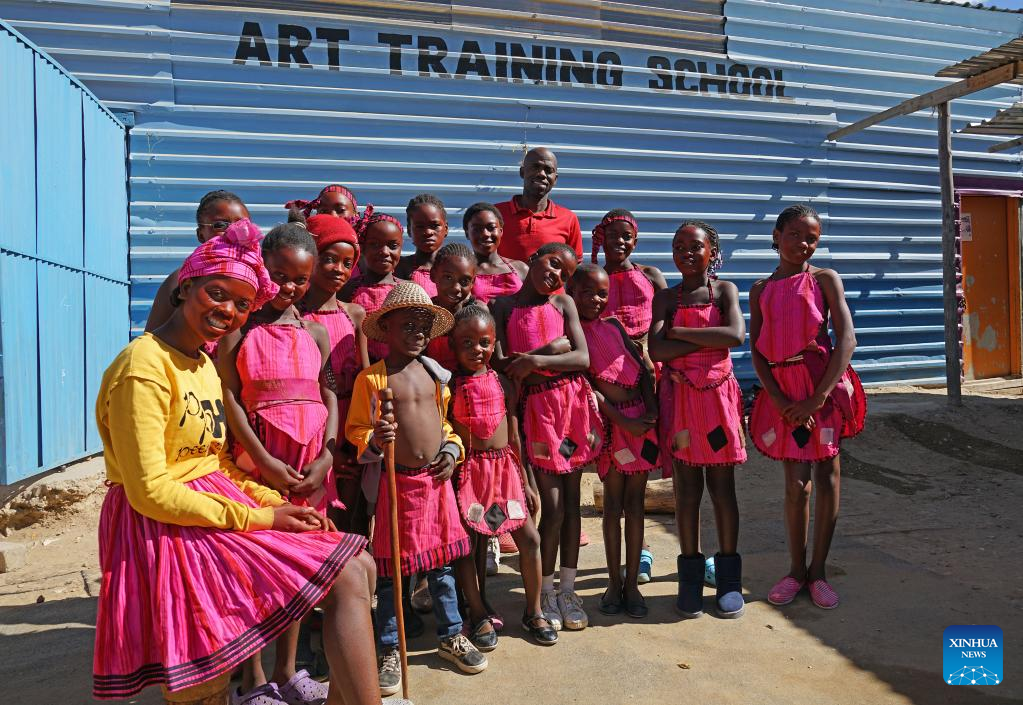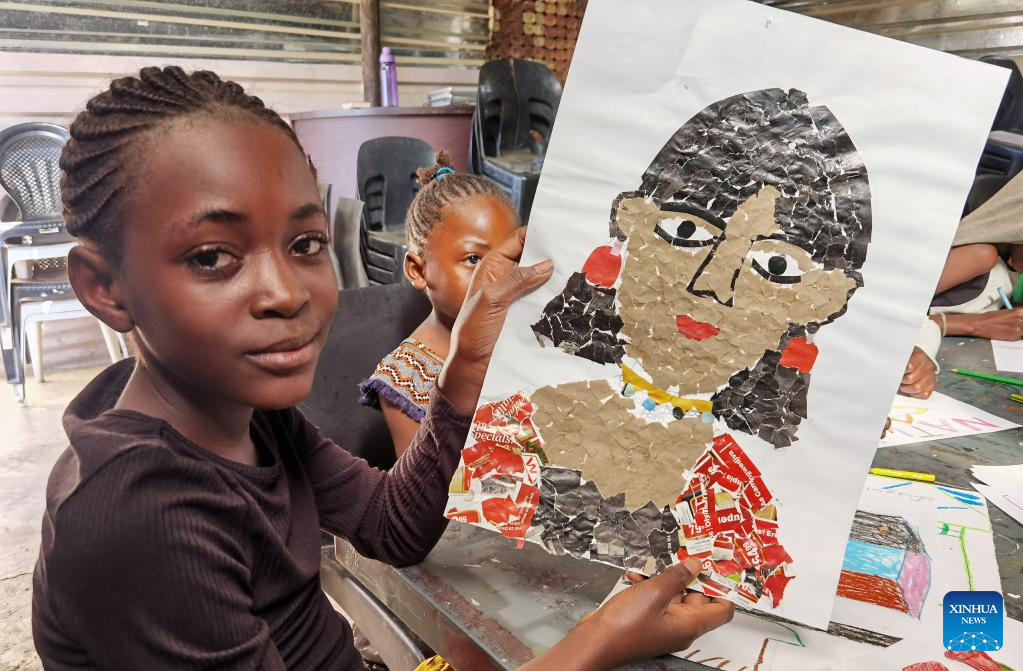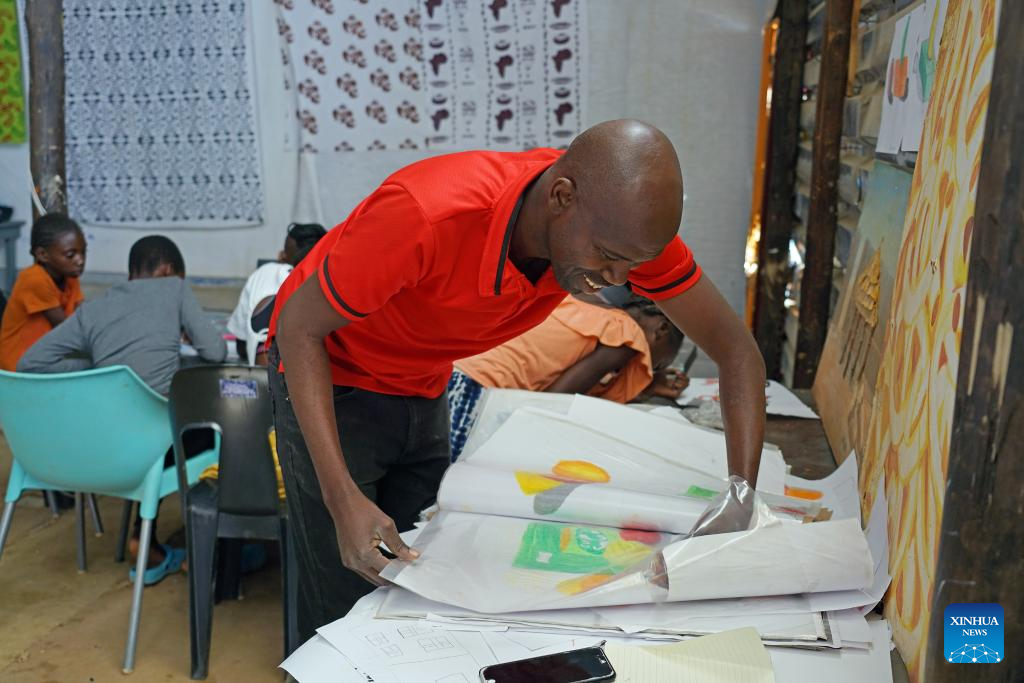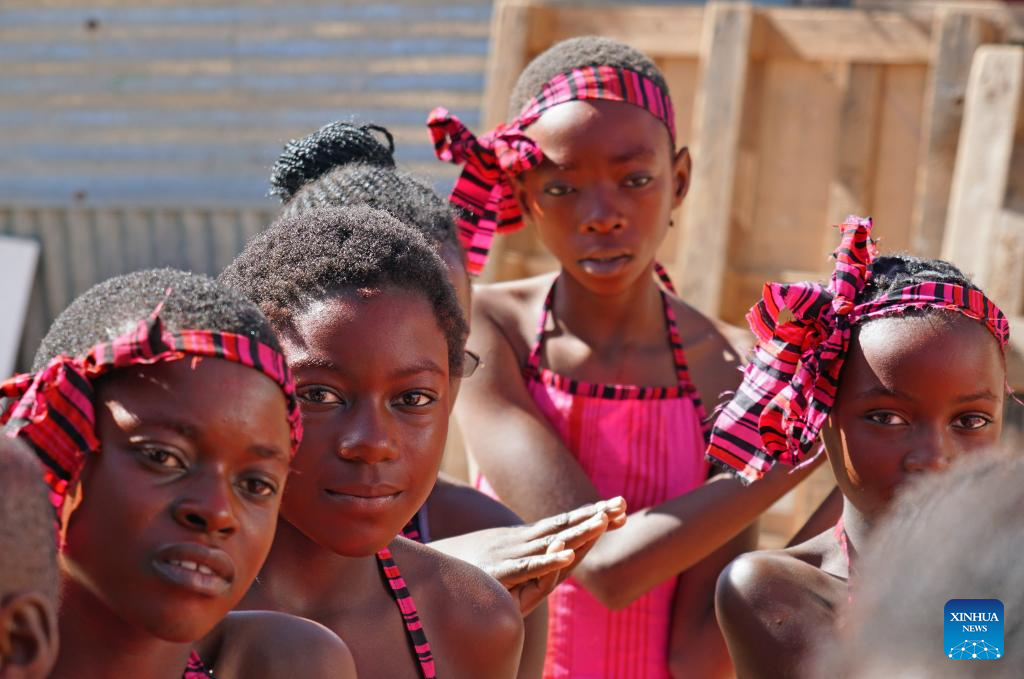
Students and teachers of the Frans Nambinga Art Training School pose for a group photo in Windhoek, Namibia, June 30, 2022. (Photo by Ndalimpinga Iita/Xinhua)
WINDHOEK, July 4 (Xinhua) -- At a structure made out of corrugated iron in Havana informal settlement on the outskirts of Windhoek, capital of Namibia, children were drawing images of idyllic scenes of peace, social issues, objects and ideal environments, reflecting their aspirations.
"This is a poster of a lady. I used an old magazine, discarded box, which I pasted on paper, and then coloured it. I like drawing beautiful ladies; imagining a world where society protects women," 13-years old Lavinia Tobias interpreted her drawing.
Tobias is one of the 40 youngsters hosted at the Frans Nambinga Art Training School in Havana, one of Windhoek's most populated informal settlements.
The school, started in 2018, is teaching art techniques to children and youth amid perennial challenges in informal settlements.
"We offer performing and visual arts classes to people in the community. Not only to nurture talent but to avoid children being pushed into sly activities on the streets," said Frans Nambinga, artist and school founder.
A trip to China, where Nambinga partook in a six-month-long program under the Forum on China-Africa Cooperation held in Hangzhou in Zhejiang province in China in 2013, further ignited the idea.
"In China, I learned a lot about the creative art industry, especially after visiting museums, galleries, factories, and observing how they run art programs for children," he said.
Nambinga also lends industry experience and qualifications from the College of Arts and John Muafangejo Art Centre to impart skills.
The school also fuses art education with culture in the form of history, dance and food to transmit traditions across generations, according to Letisia Hamukoto, a trainer at the school.
The school has since given a chance to feed the dreams of young people, with many keen to make art their mainstay.
Tobias, who started the program at the age of six, said it had become her escape from the bustle of streets in the informal settlement.
"I feel safer here rather than being on the street. Art allows me to dream and share my artistic passion with friends and neighbours. I hope to go far with it, even China or America, to showcase my craft and learn from others," Tobias said.
The youngsters also learned social skills. "Being here teaches me how to mix and work in a team with others," said 12-year-old Leticia Ndamekele, who has been with the program since 2019.
What is more, extramural activities at the art school have a ripple effect of improved academic performance in mainstream schools, especially in art subjects.
"We received feedback that school-going children develop a different way of thinking and exhibit more confidence in presentation," Nambinga said.
Moreover, it also creates employment and study opportunities for the youth.
"The youth maximize skills learned to make a living through music or visual arts. We also provide those who wish to pursue further studies with a certificate and portfolio that would qualify them for admission into art colleges," he added.
In the interim, the centre has registered an increasing demand for arts education in the area, creating both benefits and unintended challenges. COVID-19 outbreak, inadequate space, resources and funds to expand are a hurdle. This is more so because artistic work, mainly the school, is the primary source of income.
"This is my lifeline. However, programs do not always generate substantial income as most locals and parents cannot afford to pay the standard 100 Namibian dollars (6.72 U.S. Dollars). I do not chase them away; I teach them regardless," Nambinga said.
Complementary support also comes from collaborating with institutions on joint projects.
According to Nambinga, some institutions partner with the school to execute an idea through an exhibition or performing arts to raise awareness about a social issue.
"Host institutions fund such projects, which brings in an income. But we need more support," he added.
Despite the challenges, Nambinga hopes to grow the school and accommodate more children.
"It is not easy being an artist in Namibia due to limited support and commercial prospects. But I am optimistic about the future. We hope to expand through continued strategic collaborations to nurture youngsters, so they succeed," he said.
The art school has trained about 100 young people since its inception. ■

A child displays a drawing made of recycled materials at the Frans Nambinga Art Training School in Windhoek, Namibia, June 30, 2022. (Photo by Ndalimpinga Iita/Xinhua)

Frans Nambinga, artist and founder of the Frans Nambinga Art Training School, helps children collect their paintings in class in Windhoek, Namibia, June 30, 2022. (Photo by Ndalimpinga Iita/Xinhua)

Children prepare for dance training at the Frans Nambinga Art Training School in Windhoek, Namibia, June 30, 2022. (Photo by Ndalimpinga Iita/Xinhua)



